The strangest musical instrument. Encyclopedia of Musical Instruments
Picasso guitar is a strange musical instrument created in 1984 by a Canadian master string instruments Linda Manzer for jazz guitarist Patrick Bruce Metheny. It is a harp guitar with four necks, two sound holes and 42 strings. The instrument was named due to its external resemblance to those depicted on famous paintings(1912–1914), the so-called analytical cubism of Pablo Picasso.
It features a seven-handed fan of thin ribs under the bridge. He established a standard menstrual menstrual diagnosis of 65 cm, allowing for easy reproduction, a wider and higher tie, and simplified the decor for a modest flash of lubricants and rosettes around the hole. His models serve as ideal designs for modern builders. A string instrument is a stringed instrument - a chord whose strings are vibrated by a loop. Early stringed instruments include the medieval fidula and the rubeba, a successor to the Arabic Rabbah.
From these instruments the modern violin and violin instruments developed over the following centuries. A deep tradition of string instruments is also found in Asia - in China, popular instruments are the two-string violin erhu type, the Indian sarani and sarinda with three or four four mains and a lot of decoration, the traditional Japanese string instrument. In addition, there are many historical string instruments. who practically do not play: ruby and fidula, lyra da gamba, viola da braccio, lyra da braccio, papa, truststat, bastard of violas, baritone, viola d'amore and others.
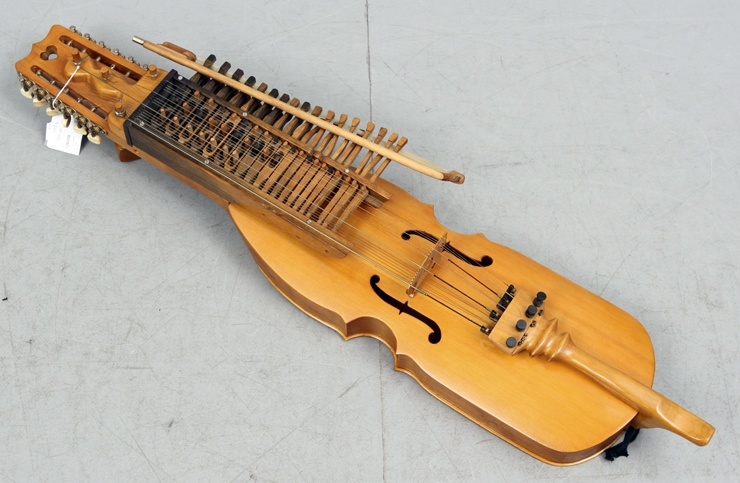
The Nyckelharpa is a traditional Swedish stringed musical instrument, first mentioned around 1350. Typically, a modern nyckelharpa has 16 strings and 37 wooden keys sliding underneath the strings. A short bow is used to play. The sound produced by this instrument is similar to the sound of a violin only with greater resonance.
It was popular in this century, mainly in Italy and France, as a single solo instrument. It is shaped like old violins and is struck with a long stick on the head that has up to fourteen pins to stretch the strings. From five to seven gut strings are fed through the fingers, and the same number is placed under the fingerboard metal strings. They are tuned according to the tactile strings. The sound of this viola is gentle and sweet.
Loop playing resembles a violin with less pressure on the strings. Unlike the viola da braccio, the viola da gamba has six or seven lines and a fret on the fingerboard. This instrument keeps the knees in play and the bows are held differently than the habit of modern instruments. There are more options gambling, alto, tenor, bass and double bass. The fuse instrument is arched, but significantly smaller than a violin. Like most other stringed instruments, the top is made of spruce, back and maple. Viola da Gamba also lies under the highest strings of the soul and under the deepest string bass.
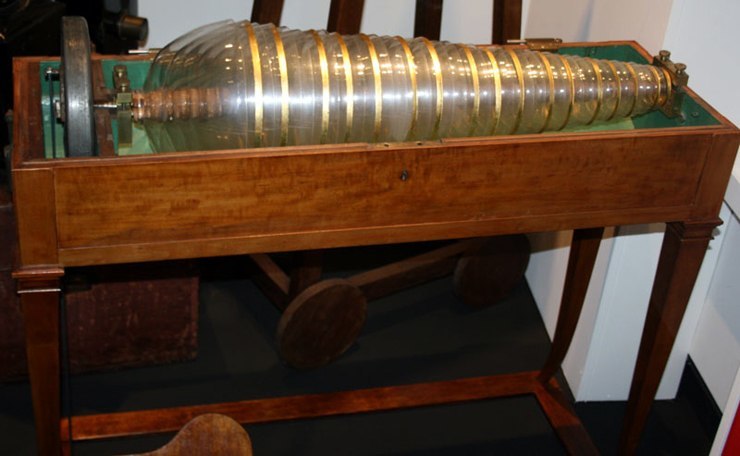
The glass harmonica is a rather unusual musical instrument, consisting of several glass hemispheres of various sizes mounted on a metal axis, which is partially immersed in a resonator box containing diluted vinegar. When touching the edges of the glass hemispheres, rotating by means of a pedal, the performer produces gentle and pleasant sounds. This musical instrument has been known since the middle of the 17th century. Interestingly, in some cities in Germany it was prohibited by law, since in those days it was believed that the sound of the harmonica had too strong an effect on state of mind people, scares animals, causes premature birth and even leads to mental disorder.
At that time, many were created for this instrument. musical works. Chamber ensembles consisting of more gambling. Beginning with the late Baroque, the gamba began to be replaced by more modern instruments such as the viola or cello. Viola da Bardone, also called baritone, originated in the century. Tenor Violet Viola da gamba with gut strings and ten to fifteen matching metal strings under the fingerboard. Beginning with violin playing, the scale was distinctive in that its lower strings could be played with a pizzit with the left thumb in a hole in the lower neck.
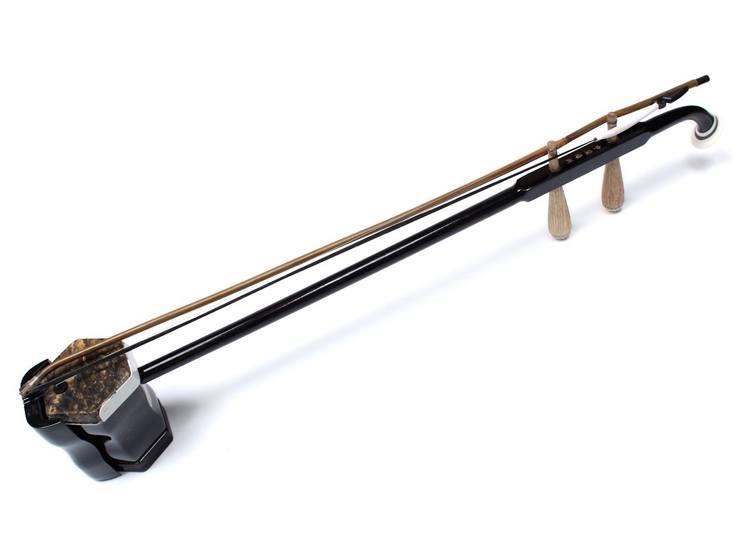
Erhu, also called "Chinese violin" - an ancient Chinese string instrument bowed instrument, created in the seventh century. It is an original two-string violin at the bottom, to which is attached a cylindrical resonator equipped with a membrane made of snake skin. A very versatile instrument, it is often used as a solo instrument, as an accompanying instrument in Chinese opera, as well as in modern musical genres such as pop, rock, jazz, etc.
It had five strings and was used in the seventeenth and eighteenth centuries to play in deeper bass positions, especially during parades. Hoffmann is like a violin, but with the addition of a fifth violin string. They have a deep European tradition classical music, most composers have devoted an important part of their work. They are the smallest of the violin family of instruments. The top plate is primarily made of spruce, while the bottom and bottom plates are made of maple. The edges of the boards are trimmed with decorative trim, which, in addition to its aesthetic function, partially protects the boards from cutting.
Zeusaphone

Zeusaphone, or "musical lightning", "singing Tesla coil" is a form of plasma loudspeaker. It is a Tesla coil that has been modified to produce sounds accompanied by the beautiful glow of air ions in an electric field high voltage. The term "Tesla Coil Singing" was coined by David Nunez following a public demonstration of the device on June 9, 2007 in Naperville, Illinois, USA.
On the other hand, souls transmit high frequencies from top to bottom. The neck is made from the same wood as the bottom plate and bulb, most often maple. It has ebony wood tiles attached to its top. The grasshopper is made of maple wood and has several important features: it holds the strings at a certain distance from the fingerboard. Its rounded shape allows the string to touch the strings separately. It carries the vibrations of the strings on the body of the violin. It serves as an acoustic filter - it limits certain string frequencies that would degrade the tone properties of a violin.
Hydraulophone

The hydraulic phone is a strange acoustic musical instrument that operates on the principle of converting vibrations of liquids into sound. It has several holes through which streams of water shoot and when one of the streams is blocked, the instrument produces a sound formed not by air, but by water. It was invented by Canadian scientist and engineer Steve Mann. The world's largest hydraulic phone is located in scientific center Ontario, Canada.
Even a slight deviation in the location of the grasshopper results in a significant change in the tone character of the violin. The blade is made of wood, bone, metal or plastic and has strings attached to it. From the bottom of the bar is a thread that is attached to the so-called glaze.
This ensures that the buckler does not touch the top of the violin. Brushes can also be attached to the groove, which can be used to make small changes in pitch when debugging. There are also shortcuts with built-in tuners. The hardwood is used to make strings. While the main portion of the loop length has a circular cross-section, the ends flare out and adapt to accommodate weave. To the pointed end, which is referred to as the tip, the hair is firmly attached.

The Singing Tree is a unique musical sculpture located in the Pennines near Burnley in Lancashire, England. The sculpture was built on December 14, 2006 and is a three-meter structure consisting of galvanized steel pipes of different lengths, which, thanks to wind energy, emit a low melodic hum.
At the opposite end of the weave tension there is a so-called frog, which can be moved using a tension screw along the rod. The frog is sometimes decorated with pearl elements on the sides for decorative purposes. The sound of a line is achieved by pulling out one or two adjacent lines. Due to the fact that the lines do not lie in one plane, but are stretched out as if they were on the surface of a cylinder, the desired line or string of lines can be selected by tilting the loop. To increase frictional resistance, rosin is applied to the horse.

Theremin is an electromusical instrument created by Russian physicist and inventor Lev Theremin in 1919. The main part Theremin are two high-frequency oscillatory circuits tuned to a common frequency. Electrical vibrations of sound frequencies are created by a generator using vacuum tubes, the signal is passed through an amplifier and converted into sound by a loudspeaker. Playing the theremin involves the performer controlling its operation by changing the position of the palms near the antennas of the instrument. By moving the hand around the rod, the performer adjusts the pitch of the sound, and gesturing around the arc allows one to influence the volume. By changing the distance of the musician's palms to the instrument's antenna, the inductance of the oscillatory circuit changes, and as a result, the frequency of the sound. One of the first and most prominent performers on this instrument was the American musician Clara Rockmore.
The string lines are shaken with lateral attraction. The oldest loops were very different from today's - the shape resembled a bow, and the hair was firmly attached at both ends. The tension of the scales was achieved by pressing the finger, the middle of the hanging da da gamba and the thumbs on the violin. In the middle of the century, loops began to be equipped with a serrated rod, which allowed the weave to be gradually tightened. In the middle of the century it was developed modern form trigger with a screw that allows you to adjust variable tension.
This increased the maximum load and extended play through looping, such as faster staccato play. However, when play is finished, tension in the weave must be released to avoid warping on the shaft and long-term stress on the weave. More recently, hinges are also made from carbon composite materials.

In second place in the list of the most unusual musical instruments in the world is the Hang - musical percussion instrument, created in 2000 by Felix Rohner and Sabine Scherer from the Swiss city of Bern. It consists of two interconnected metal hemispheres with a resonator hole measuring 8–12 cm.
The predecessor of the violin is the medieval ruby, the successor of the Arabic fretwork, the violin or fidula and the relative lyre da braccio. The first violin began in Italy at the beginning of the century. None of them survived, but their shape can be traced to drawings of the time. The first modern violin was built by Andrea Amati at the request of the Medici family - he was asked to create an instrument suitable for street musicians. Modern violins quickly became popular in all social classes and spread throughout Europe.
The oldest surviving violin was also made by Andrea Amati, Cremona Goda. They were never played for them and are now on display in the Ashmolean Museum in Oxford. The most famous violinists lived for centuries. The shape of the violin has remained virtually unchanged since then, with only minor changes in structure. The violins made by eminent violinists during this period are still virtually inimitable in tone, and today there are conflicts over what is actually caused. viola.
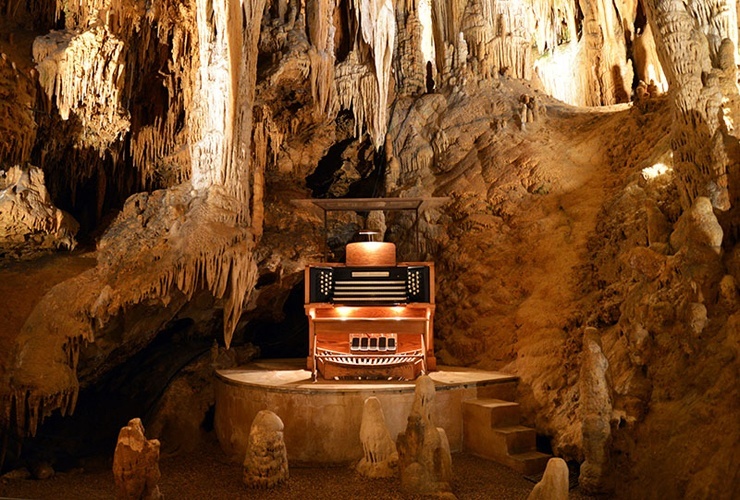
The most unusual musical instrument in the world is the Stalactite organ. This is a unique musical instrument located in Luray Caverns, Virginia, USA. It was created in 1956 by mathematician and scientist Leland Sprinkle, who throughout three years processed stalactites hanging from the ceiling of a cave to obtain the perfect sound. After which he attached a hammer to each of them, controlled by electricity from an organ keyboard. This instrument covers an area of 14 square kilometers and is the largest musical instrument in the world.
It is very similar to a violin, it is a little larger. Its strings are slightly lower than the violin. The sound of the creak is filled and somewhat dark and melancholic. At the top of the string, its tone is somewhat reminiscent of a violin, but it lacks its lightness and brilliance. The tone colors of a viola are related to its size. Since the viola has less acoustic aspect, the higher harmonic frequencies are suppressed, causing different tone characteristics than the violin. The violin string is slightly shorter and more powerful than the violin. String methods are basically the same as violin, but more strings are needed to make them sound strong forces.
Share on social media networks
10
The octobass is an instrument that stands out, first of all, for its size: the largest specimens can reach a height of 4.5 meters and be 2 meters wide. It appeared as a result of experiments violin makers, who believed that the dimensions of the double bass body were not large enough for low sounds. With the creation of this impressive instrument, they managed to solve the problem: the octabs range is from C to sub-contractive (16.4 Hz) to A counter-octave (55 Hz), thus, there was no point in creating lower-sounding instruments of this kind, since the lower limit of the audible range for human (16 Hz - 20 kHz), and more low sounds it would simply be inaudible. However, the octobass did not become widespread due to the fact that it did not have the expected strength and richness of sound. But nevertheless, this instrument can still be found in some musical performances. Due to its impressive size, the technique of playing the octobass has its own characteristics. It is played while standing, standing on a special stool. In this case, the strings are pressed using a special manual mechanism - for this purpose, 7 levers are made in the octobass, which allow you to simultaneously press all the strings on any of the frets, from 1 to 7, respectively.
The viola is an integral part of every string quartet and quintet. He often plays important role in the orchestra, but only complements the function - its part is limited to filling the harmony between the other violins and the cello. cello. The cello has almost the same structure as the violin. Compared with violins, the length of the cello cello is about twice the height of the tortillas, about four times. This relativizes the first aliquot tone, which results in the typical warmth of cello tone.
These instruments were developed in parallel with the so-called viola instruments. Unlike today's instruments, the celluloid cello had no splash and had to fit snugly between the knees; the wooden part of the baroque strings was curved, currently it is curved over all the instruments inside. The cello produces a rich and warm sound, in some positions very similar to human voice. When playing high tones, the pitch is reminiscent of an alto. For its resonance the jaw must develop relatively high strength.
9 Cigarbox guitar
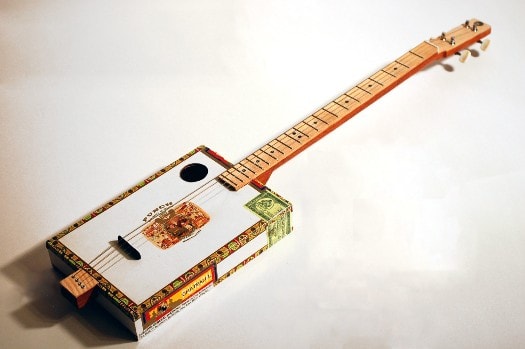
From the name of this stringed instrument, you might think that it is made from a cigar box. This is true! Initially, cigar boxes were made from cigar boxes, as well as other suitable containers. This is due to the fact that often the first creators of this instrument (black American slaves of the 19th century) did not have the opportunity to buy a guitar, but they had the desire to play, resourcefulness and available materials. Why did you usually come across cigar boxes? The fact is that at that time cigars were stored and transported in wooden boxes, which, as they say, were not made from the worst wood. Naturally, as a rule, no one kept these boxes, and a lot of them were thrown away.
It is very often used in solo compositions. At higher positions the cello sounds like a viola. Before women it was sad to play the cello this way, so they had the instrument leaning against the ground next to both feet. The playing methods are basically the same as violins or fiddles. The cello is also used in the so-called "thumb" position, where the left thumb types two lines, usually at the level of the top plate, and the other fingers type separate lines.
Double bass. There is still inconsistency as to whether the double bass belongs to the violin or viola string instruments. Unlike other strings, the design of the double bass was not standardized; the structure oscillates more or less between violins and gambas. For example, the bottom plate can be curved like a violin, straight like a gambler, or slightly bent. As with other stringed instruments, the sides and backplates are made from maple and spruce wood. Cloves are most often made from ebony wood.
8

Essentially, this instrument is a modernization of the guitar by adding additional strings to expand its sound range and other practical purposes. There are different options execution: shapes and design depend only on the skill and imagination of the master.
The single bass is always about an octave lower than the notation. The playing methods are basically the same as for other string instruments, as for the cello, the technique thumb used when melodies are played with the left thumb. It is generally more difficult to play fast and technically challenging passages on a bass bass than on a violin, for example, because the bass strings are stronger and the distance between the tongues on the flip chart is greater. In Baroque music, the basso bass and cello played an important role in the bass voice, the so-called basso continuo.
Until the beginning of the century, songs for solo double bass practically did not exist. The playing of period instruments is becoming more and more noticeable. Musicians are now given much more guidance about authentic interpretation. Thanks to the efforts of many scientists, archives are opened, textbooks are opened and teaching aids about how to play this kind of music. We, of course, do not know how musicians played in the eighteenth century, but we already have some idea, and replicas of historical instruments allow us to bring together subtle nuances.
7
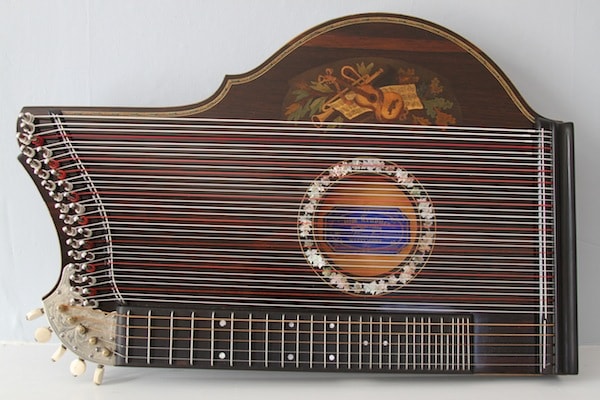
Conceptually, this tool is in some ways the opposite of the previous one. Figuratively speaking, a zither is a harp with a neck and frets.
Depending on the size, the zither has from 17 to 47 strings. The first four or five strings, located above the fretted fretboard, usually play the main melody, and the rest provide chord accompaniment. The zither was most popular among residents of Austria and Germany in the 18th century.
6 Hurdy-gurdy (organist)
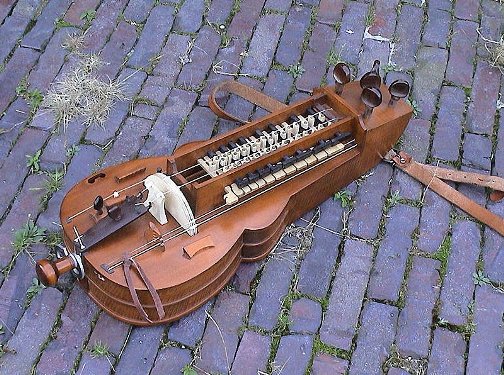
An ancient musical instrument that produces a buzzing, drawn-out sound that occurs due to the friction of the strings on a wheel rotated by the musician. Some strings play the main melody using rod-keys, while others produce a constant bourdon background.
5 Wheelharp

Original modern instrument, which has some similarities in the principle of sound production with a hurdy-gurdy: sound also appears as a result of the friction of a rotating drum on the strings. But that's where the similarities end. When you press a key, the mechanism moves the corresponding string towards the drum, the surface of which is covered with rosin. In addition to the keyboard with a range of 3-5 octaves, two pedals are used for playing. The left pedal controls the damper (muffles the sound of the strings), and the right pedal controls the rotation speed of the drum.
4 Glukophone and hang
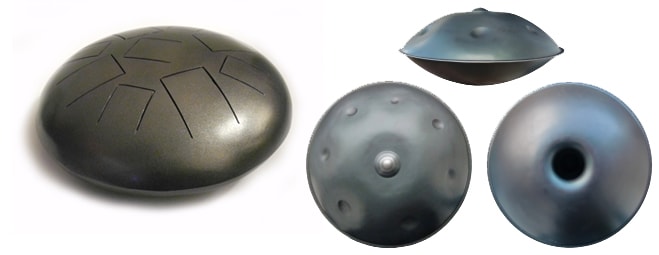
The glucophone, like the previous instrument, is a modern invention. Initially, its prototype was made from a gas cylinder. The glucophone consists of two bowls, on one of which there are petals (drum reeds), and on the other there is a resonating hole. Each bowl is customizable in the right way to give the necessary pure and rich overtone sound. Various modifications are possible: changing the geometry of the impact elements, changing the volume of the tool and the thickness of the body wall.
Hang is a metal percussion instrument similar to a glucophone. Unlike the glucophone, the hanga, instead of sounding reeds, has 7-8 tonal areas on one of the hemispheres surrounding the central dome.
3

A rare musical instrument consisting of glass hemispheres of various sizes strung on a horizontal rotating metal axis. The package of hemispheres is partially immersed in a resonator box with diluted vinegar, due to which the edges of the hemispheres are constantly moistened. Immediately after its creation ( mid-17th century century), the harmonica began to captivate composers, musicians and just listeners with its magical, fabulous and, at times, mysterious sounds. They wrote these for her famous composers like Mozart, Beethoven and Strauss. However, despite such success and universal sympathy, due to various prejudices and superstitions, the harmonica began to lose its popularity, and in some cities in Germany it was even banned. As a result, glass harmonicas became rare by the twentieth century.
2

An instrument with a long history and wide geography. Archaeological finds and ethnographic studies confirm that it was common among many peoples throughout To the globe. U different nations this instrument is known under different names: khomus, jaw's harp, kumyz, shankobyz, temir-khomus, yayar baths, maultrommel dan moi, kousyan, marranzano, doromb, mukkuri, morchang, dambrialis, etc. Apart from slight differences in the shape and materials used during production, general principles games and sound production are similar. To play, the instrument is held by hand and pressed with the body against the teeth so that nothing interferes with the free vibration of the reed, which is the primary source of sound. The tongue is driven by the performer's free hand. Sound amplification occurs due to the oral cavity, which acts as a resonator. Accordingly, changes in the pitch and timbre of sound occur through changes in articulation, breathing and other techniques, among which there are both simple and those requiring some skill of the performer.
1

An electromusical instrument designed and created in 1919 by Russian inventor Lev Sergeevich Termen in Petrograd. Since the creation of the first one (“Classic”, with two antennas), several modifications and upgrades of the instrument have been created.
In the first, classic models, created by Lev Theremin himself, sound control occurs as a result of the free movement of the performer's hands in an electromagnetic field near two metal antennas. The performer plays while standing. Changing the pitch of the sound is achieved by moving the hand closer to the right antenna, while the volume of the sound is controlled by bringing the other hand closer to the left antenna. It is this model of theremin that is most widely used in the world.







